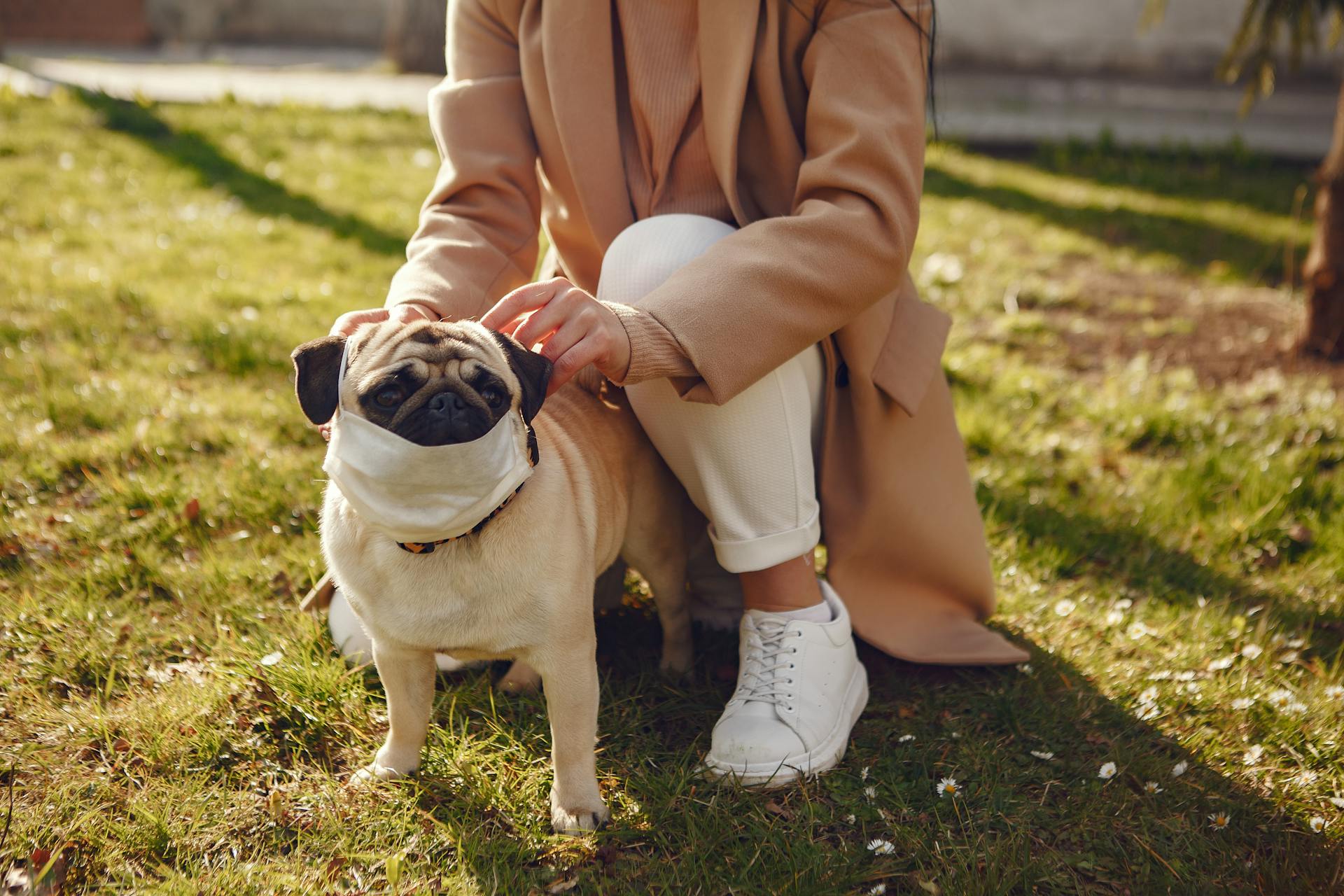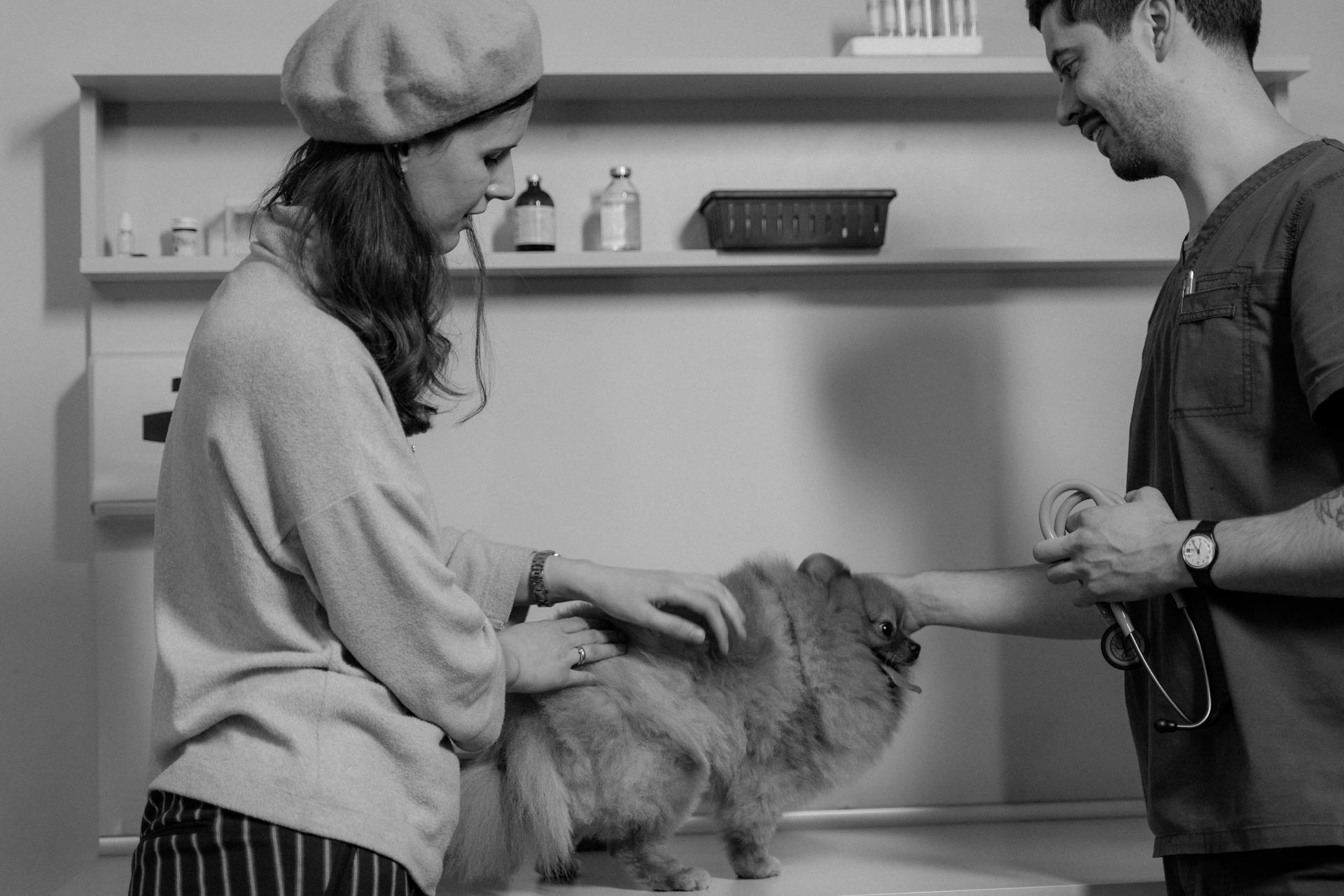
Female dogs typically start bleeding between 6 to 12 months of age, depending on their breed and size.
This bleeding is a result of their first heat cycle, which can last anywhere from 2 to 4 weeks. During this time, they may be more receptive to breeding.
The frequency and duration of heat cycles can vary, but most female dogs experience one every 4 to 6 months.
Understanding the Canine Cycle
The canine cycle is a vital aspect of a female dog's life, and understanding it can help you provide the best care for your furry friend. Female dogs typically experience their first heat cycle between six and 15 months of age, with toy breeds starting as young as four months and giant breeds not reaching their first heat cycle until two years old.
A typical heat cycle lasts 2-3 weeks, and it's the moment when a dog can get pregnant. Sperm can live in a dog's birth canal for days, so if you don't want puppies, it's best to keep your pup from her admirers for the whole heat.
On a similar theme: Why Does My Male Dog Lick My Female Dogs Pee
The canine cycle has four stages: proestrus, estrus, diestrus, and anestrus. Proestrus is the start of the heat period, characterized by a swollen vulva, blood-tinged discharge, and clingy behavior. Estrus is the mating phase, where your female dog will be receptive to males and may need to urinate more frequently.
Here's a breakdown of the four stages:
- Proestrus: 7-10 days, vulva swells, bleeding starts
- Estrus: 5-10 days, bleeding reduces or stops, dog is ready to mate
- Diestrus: 10-140 days, dog is either pregnant or in a period of rest
- Anestrus: 6 months, inactive phase with no signs of hormonal or sexual behavior
The frequency of the canine cycle depends on the dog's size, breed, and age. Small breeds may experience heat more often, every four months, while giant breeds may only cycle once a year. On average, dogs have two heat cycles per year, roughly six months apart.
To manage your dog's heat cycle, it's essential to keep her indoors and supervised, especially when she's on her period. You can use diapers and washable diaper liners to prevent messes and make cleanup easier. With proper care and attention, you can help your dog navigate this natural process.
Recommended read: What Breeds of Dogs Are Prone to Deafness
Recognizing Physical and Behavioral Signs
Recognizing the physical signs of a female dog in heat can be a bit alarming at first, but it's a normal part of their reproductive cycle. A swollen vulva and bloody or straw-colored discharge from the vulva are common indicators that your dog is in heat.
You may also notice your dog licking her genital area more frequently than usual, which can be a sign that she's preparing for mating. This behavior is especially common in the first phase of estrus.
As your dog's cycle progresses, you may notice changes in her tail position, such as holding her tail to the side, which can alert male dogs that she's ready for mating. Some dogs may also exhibit signs of agitation, nervousness, or aggression, especially towards other household pets.
Check this out: Female Dog First Heat
When to Go First
As a dog owner, it's essential to know when your furry friend is first going into heat. A female dog can first experience her heat cycle as early as six months of age.
For your interest: When Does a Female Dog Get Her First Period

The age of first heat can vary significantly depending on breed, with smaller dogs often experiencing it earlier than larger ones. A larger dog may not experience her first heat cycle until up to two years of age.
This means that even if you've had your dog since she was a puppy, you may not be aware of her first heat cycle. Be prepared for the possibility of an unexpected heat cycle at any time.
Female dogs will continue to experience heat cycles throughout their lives, with the time between each cycle increasing as they age.
A unique perspective: How to Tell the Age of a Female Dog
Physical Signs
Your dog's vulva will swell and redden when in heat, making it a normal yet alarming sight for first-time dog owners.
A swollen vulva is a clear indicator that your dog is in heat, and it's a sign you can look out for during each phase of her cycle.
The discharge from your dog's vulva will typically start as bloody and may leave blood spots or stains, especially at the beginning of estrus.
As estrus continues, the discharge will usually become a yellowish or brownish color and decrease in quantity.
The physical signs of your dog being in heat can be a bit messy, so be prepared for some unexpected stains on your furniture or floor.
Take a look at this: Female Dog Estrous Cycle
Common Behaviors

As your dog approaches her heat cycle, you may notice some changes in her behavior. She may become more receptive to male dogs, allowing them to mount her and even trying to mount other pets in the house.
A dog in heat will often exhibit agitated, nervous, or aggressive behavior, especially in the first phase of estrus. This can be directed towards other household pets or even towards you.
You may notice your dog licking her genital region more frequently than usual, which is a common sign of her heat cycle.
Dogs in heat tend to urinate more frequently, often as a way to alert male dogs in the area that they are receptive to mating.
If you're lucky enough to have a dog that's friendly with other dogs, you may see her flirting with them, which can be a sign that she's in heat.
Here are some common behaviors to look out for during your dog's heat cycle:
- Receptive to male dogs
- Agitated, nervous, or aggressive behavior
- Excessive licking of the genital area
- Urinating more frequently
- Flirting with other dogs
Health Concerns and Treatment
Female dog bleeding can be a distressing issue for many pet owners.
The most common cause of female dog bleeding is uterine infections, which can be prevented with regular veterinary check-ups and proper care.
Some breeds, such as the German Shepherd, are more prone to uterine infections due to their anatomy.
Proper care includes keeping your dog's living area clean and free of bacteria, which can help prevent infections.
Regular check-ups can also help detect any underlying health issues early on, such as Cushing's disease, which can cause excessive bleeding.
Related reading: How to Care for a Female Dog in Heat
What Is Pyometra?
Pyometra is a life-threatening infection that occurs in female dogs that have not been spayed. It's a serious condition that requires prompt attention.
The infection happens because of hormone changes in the dog's body that trigger pus in the uterus. This is a result of the dog's heat cycle, which causes the lining of the uterus to thicken and prepare for pregnancy.
Recommended read: American Bully Ear Infection
Progesterone stays elevated for about two months after the heat cycle, making the lining of the uterus even thicker. This creates an ideal environment for bacteria to grow and cause infection.
The cervix is relaxed during the heat cycle, allowing bacteria from the vagina to enter the uterus. The thick lining of the uterus then provides a fertile ground for bacterial growth.
If several heat cycles pass without pregnancy, the lining of the uterus continues to thicken, and cysts develop within the uterine tissues. This can lead to the secretion of fluid that promotes bacterial growth.
You might enjoy: Does Spaying a Female Dog Affect Her Growth
Symptoms of Open Pyometra
Symptoms of open pyometra can occur anywhere from two to eight weeks after your pup's heat cycle, but it could be as late as twelve weeks.
Excessive licking after the heat cycle is a common symptom of open pyometra. This is likely due to the discomfort and irritation caused by the infection.
Here's an interesting read: How Long Does Pyometra Take to Kill a Dog
White, yellowish, or green discharge can be seen, and it may start out clear. This discharge can have a foul-smelling odor.
Changes in behavior, such as depression, can also occur. This can be a sign that your pup is not feeling well.
Increased thirst and urination are also symptoms of open pyometra. This is because the body is trying to flush out the infection.
Vomiting and diarrhea can also occur. These symptoms can be a sign that the infection is spreading.
A lack of appetite and energy can also be symptoms of open pyometra. This is because the infection can cause a range of systemic symptoms.
Some common symptoms of open pyometra include:
- Excessive licking
- Discharge (white, yellowish, or green)
- Changes in behavior
- Depression
- Increased thirst
- Increased urination
- Vomiting
- Diarrhea
- Lack of appetite
- Lack of energy
Pyometra Treatment
Pyometra Treatment is a serious concern for dog owners, and it's essential to take immediate action if you suspect your dog has this condition. An emergency spay is the preferred treatment of choice in most veterinary hospitals.
Surgery is usually recommended because it addresses the condition's urgency and prevents a future recurrence. Your veterinarian will likely encourage you to go this route.
Here's an interesting read: Female Dog Prolapse Treatment
In some cases, a dog with an open pyometra may not require surgery, but this method is not without risks. There is often a good chance that the pyometra will return unless the pup is pregnant during their next heat cycle.
If your dog has pyometra, it's crucial to get them to the vet right away. The following steps must be taken:
- Get your pup to the vet
- Find out whether your pup has open or closed pyometra
- Rehydrate your dog at the vet to replace the loss of fluid
- Give your pup any medicine that may be prescribed
- Discuss spaying your dog and other options with the vet
After surgery, it's essential to follow your veterinarian's instructions to ensure a smooth recovery. This includes avoiding heavy activity for about two weeks after surgery and bringing your pup to the vet to have stitches removed.
A different take: How Long Is a Spay Surgery for Female Dog
Spaying and Its Benefits
Spaying your dog can greatly reduce the risk of certain health issues, including pyometra, transmissible venereal tumor, mammary tumor or breast cancer, and uterine or ovary cancer.
Spaying is recommended when your dog is about six months old, but it's essential to talk to your veterinarian about your dog's unique needs.
A different take: Dog Names Female Start with S
Dogs are in heat for a week-and-a-half to two weeks, and the bleeding or discharge can last for the entire heat cycle.
The best way to keep your house clean during this time is to outfit your dog in a heat diaper or keep her off furniture and carpeted areas.
Spaying your dog can also save her from going through her heat cycle continuously, which can be a relief for both you and your dog.
Here are some potential health risks associated with spaying:
- Pyometra
- Transmissible venereal tumor
- Mammary tumor or breast cancer
- Uterine or ovary cancer
It's also worth noting that your dog's personality may change in some ways around her first heat, but she won't necessarily become a completely different dog.
Frequently Asked Questions
How long after a female dog bleeds is she in heat?
A female dog is likely in heat 9-10 days after bleeding starts, but the end of bleeding is a more reliable indicator of peak fertility.
Why does my female dog have blood around her private area?
Your female dog's bloody discharge may be a normal part of her heat cycle, but it could also indicate a serious health issue if she's been spayed or not in heat
Why is my female dog spotting blood when he is not in heat?
Your female dog's vaginal bleeding may be a sign of a medical issue, such as a uterine infection or injury, and requires immediate veterinary attention
What does it mean when my dog is spotting blood?
Spotting blood in your dog can be a sign of a heat cycle, pregnancy issue, or a normal occurrence in some breeds. If you're concerned, it's best to consult with a veterinarian to determine the cause and ensure your dog's health
Featured Images: pexels.com


